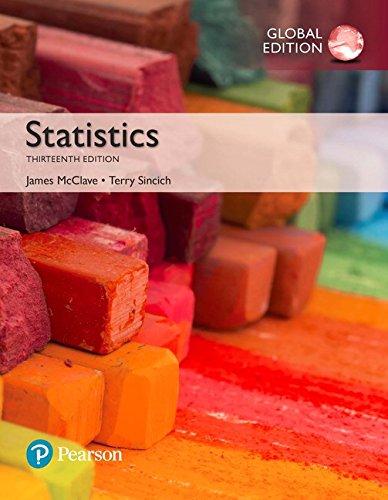Sound waves from a basketball. Refer to the American Journal of Physics (June 2010) study of sound
Question:
Sound waves from a basketball. Refer to the American Journal of Physics (June 2010) study of sound waves in a spherical cavity, Exercise 2.43 (p. 80). The frequencies of sound waves (estimated using a mathematical formula) resulting from the first 24 resonances (echoes) after striking a basketball with a metal rod are reproduced in the table on p. 125. Graph the data in a scatterplot, with frequency on the vertical axis and resonance number on the horizontal axis. Since a mathematical formula was used to estimate frequency, the researcher expects an increasing trend with very little variation. Does the graph support the researcher’s theory?
Resonance Frequency 1 979 2 1572 3 2113 4 2122 5 2659 6 2795 7 3181 8 3431 9 3638 10 3694 11 4038 12 4203 13 4334 14 4631 15 4711 16 4993 17 5130 18 5210 19 5214 20 5633 21 5779 22 5836 23 6259 24 6339 Plants that grow on Swiss cliffs. A rare plant that grows on the limestone cliffs of the Northern Swiss Jura mountains was studied in Alpine Botany (Nov. 2012). The researchers collected data from a sample of 12 limestone cliffs. Several of the variables measured for each cliff included the altitude above sea level (meters), plant population size (number of plants growing), and molecular variance (i.e., the variance in molecular weight of the plants). These data are provided in the accompanying table. The researchers are interested in whether either altitude or population size is related to molecular variance.
Cliff Number Altitude Population Size Molecular Variance 1 468 147 59.8 2 589 209 24.4 3 700 28 42.2 4 664 177 59.5 5 876 248 65.8 6 909 53 17.7 7 1032 33 12.5 8 952 114 27.6 9 832 217 35.9 10 1099 10 13.3 11 982 8 3.6 12 1053 15 3.2 Source: Rusterholz, H., Aydin, D., and Baur, B. “Population structure and genetic diversity of relict populations of Alyssum montanum on limestone cliffs in the Northern Swiss Jura mountains.” Alpine Botany, Vol. 122, No. 2, Nov. 2012 (Tables 1 and 2).
a. Use a scatterplot to investigate the relationship between molecular variance and altitude. Do you detect a trend?
b. Use a scatterplot to investigate the relationship between molecular variance and population size. Do you detect a trend?
Step by Step Answer:





